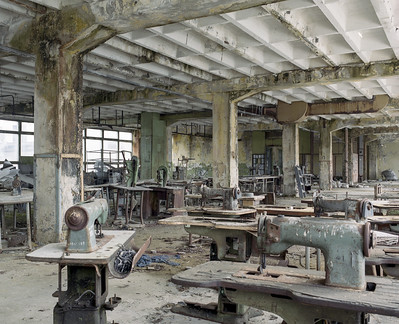Posts Tagged ‘Manufacturing Competitveness’
996 or Bust
 996 is all the rage. You work 9 am to 9 pm, 6 days a week. Startups are doing it. Might non-startups start doing it?
996 is all the rage. You work 9 am to 9 pm, 6 days a week. Startups are doing it. Might non-startups start doing it?
Productivity is important and competition is severe. And I’m all for working hard, but I don’t think the 996 schedule is the most effective way to achieve productivity goals, at least not for all jobs.
My decision-making capabilities diminish when I am tired, and I would be tired if I worked a 996 schedule. My interpersonal and organizational effectiveness would suffer if I worked 996. My planning skills would degrade if I worked 996. My family life would suffer if I worked 996. And my physical and mental health would degrade..
In my work, I make many decisions, I create conditions for teams and organizations to do new work, and I contemplate the future and figure out what to do next. Maybe I should be able to do this work well with a 996 schedule. But I know myself, and I know I would be far less effective working 996. Maybe my work is uniquely unfit for 996? Maybe I am uniquely unfit for 996?
Some questions for you:
- How many hours can you concentrate in one day?
- How about the second day?
- If you worked a 996 schedule, would you get more done?
- How many weeks could you work 996 before the wheels fall off?
The startup pace is rapid. Progress must be made before the money runs out. At these early stages, when a company’s existence depends on hitting the super agressive timelines, I think 996 is especially attractive to startup companies The potential financial upside is large which may make for a fair trade – more hours for the chance of outsized compensation.
But what if an established company sets extremely tight timelines and offers remarkable compensation if those timelines are met? Does 996 become viable? What if an established company sets startup-like timelines but without added compensation? Would 996 be viable in that case?
Some countries and regions work a 996 schedule as a matter of course – no limited to startups and (likely) no special compensation. And it seems to work for them, at least from the outside. And 996 may be an important supporting element of their impressively low costs, high quality, and speed.
If those countries amd regions can sustain their 996 culture, and I think they will, it will create pressure on other countries to adopt a similar approach to avoid falling further behind.
I’m unsure what broad adoption of 996 would mean for the world.
Image credit — Evan
It’s time for the art of the possible.
 Tariffs. Economic uncertainty. Geopolitical turmoil. There’s no time for elegance. It’s time for the art of the possible.
Tariffs. Economic uncertainty. Geopolitical turmoil. There’s no time for elegance. It’s time for the art of the possible.
Give your sales team a reason to talk to customers. Create something that your salespeople can talk about with customers. A mildly modified product offering, a new bundling of existing products, a brochure for an upcoming new product, a price reduction, a program to keep prices as they are even though tariffs are hitting you. Give them a chance to talk about something new so the customers can buy something (old or new).
Think Least Launchable Unit (LLU). Instead of a platform launch that can take years to develop and commercialize, go the other way. What’s the minimum novelty you can launch? What will take the least work to launch the smallest chunk of new value? Whatever that is, launch it now.
Take a Frankensteinian approach. Frankenstein’s monster was a mix and match of what the good doctor had scattered about his lab. The head was too big, but it was the head he had. And he stitched onto the neck most crudely with the tools he had at his disposal. The head was too big, but no one could argue that the monster didn’t have a head. And, yes, the stitching was ugly, but the head remained firmly attached to the neck. Not many were fans of the monster, but everyone knew he was novel. And he was certainly something a sales team could talk about with customers. How can you combine the head from product A with the body of product B? How can you quickly stitch them together and sell your new monster?
Less-With-Far-Less. You’ve already exhausted the more-with-more design space. And there’s no time for the technical work to add more. It’s time for less. Pull out some functionality and lots of cost. Make your machines do less and reduce the price. Simplify your offering and make things easier for your customers. Removing, eliminating, and simplifying usually comes with little technical risk. Turning things down is far easier than turning them up. You’ll be pleasantly surprised how excited your customers will be when you offer them slightly less functionality for far less money.
These are trying times, but they’re not to be wasted. The pressure we’re all under can open us up to do new work in new ways. Push the envelope. Propose new offerings that are inelegant but take advantage of the new sense of urgency forced.
Be bold and be fast.
Image credit — Geoff Henson
If you want to make a difference, change the design.
 Why do factories have 50-ton cranes? Because the parts are heavy and the fully assembled product is heavier. Why is the Boeing assembly facility so large? Because 747s are large. Why does a refrigerator plant have a huge room to accumulate a massive number of refrigerators that fail final test? Because refrigerators are big, because volumes are large, and a high fraction fail final test. Why do factories look as they do? Because the design demands it.
Why do factories have 50-ton cranes? Because the parts are heavy and the fully assembled product is heavier. Why is the Boeing assembly facility so large? Because 747s are large. Why does a refrigerator plant have a huge room to accumulate a massive number of refrigerators that fail final test? Because refrigerators are big, because volumes are large, and a high fraction fail final test. Why do factories look as they do? Because the design demands it.
Why are parts machined? Because the materials, geometries, tolerances, volumes, and cost requirements demand it. Why are parts injection molded? Because the materials, geometries, tolerances, volumes, and cost requirements demand it. Why are parts 3D printed? For prototypes, because the design can tolerate the class of materials that can be printed and can withstand the stresses and temperature of the application for a short time, the geometries are printable, and the parts are needed quickly. For production parts, it’s because the functionality cannot be achieved with a lower-cost process, the geometries cannot be machined or molded, and the customer is willing to pay for the high cost of 3D printing. Why are parts made as they are? Because the design demands it.
Why are parts joined with fasteners? It’s because the engineering drawings define the holes in the parts where the fasteners will reside and the fasteners are called out on the Bills Of Material (BOM). The parts cannot be welded or glued because they’re designed to use fasteners. And the parts cannot be consolidated because they’re designed as separate parts. Why are parts held together with fasteners? Because the design demands it.
If you want to reduce the cost of the factory, change the design so it does not demand the use of 50-ton cranes. If you want to get by with a smaller factory, change the design so it can be built in a smaller factory. If you want to eliminate the need for a large space to store refrigerators that fail final test, change the design so they pass. Yes, these changes are significant. But so are the savings. Yes, a smaller airplane carries fewer people, but it can also better serve a different set of customer needs. And, yes, to radically reduce the weight of a product will require new materials and a new design approach. If you want to reduce the cost of your factory, change the design.
If you want to reduce the cost of the machined parts, change the geometry to reduce cycle time and change to a lower-cost material. Or, change the design to enable near-net forging with some finish machining. If you want to reduce the cost of the injection molded parts, change the geometry to reduce cycle time and change the design to use a lower-cost material. If you want to reduce the cost of the 3D printed parts, change the design to reduce the material content and change the design and use lower-cost material. (But I think it’s better to improve function to support a higher price.) If you want to reduce the cost of your parts, change the design to make possible the use of lower-cost processes and materials.
If you want to reduce the material cost of your product, change the design to eliminate parts with Design for Assembly (DFA). What is the cost of a part that is designed out of the product? Zero. Is it possible to wrongly assemble a part that was designed out? No. Can a part that’s designed out be lost or arrive late? No and no. What’s the inventory cost of a part that’s been designed out? Zero. If you design out the parts is your supply chain more complicated? No, it’s simpler. And for those parts that remain use Design for Manufacturing (DFM) to work with your suppliers to reduce the cost of making the parts and preserve your suppliers’ profit margins.
If you want to sell more, change the design so it works better and solves more problems for your customers. And if you want to make more money, change the design so it costs less to make.
Effectiveness Before Efficiency
 Efficient – How do we do more projects with fewer people?
Efficient – How do we do more projects with fewer people?
Effective – Let’s choose the right project.
Would you rather do more projects that miss the mark or fewer that excite the customer?
Efficient – How do we finish the project faster?
Effective – Let’s fully staff the project.
Would you rather burn out the project team or deliver on what the customer wants?
Efficient – How do we reduce product cost by 5%?
Effective – Let’s make customers’ lives easier.
Would you rather reduce the cost or delight the customer?
Efficient – How can we go faster?
Effective – Let’s get it right.
Would you rather go fast and break things or get it right for the customer?
Efficient – How many projects can we run in parallel?
Effective – Let’s fully staff the most important projects.
Would you rather get halfway through four projects or complete two?
Efficient – How do we make progress on as many tasks as possible?
Effective – Let’s work on the critical path.
Would you rather work on things that don’t matter or nail the things that do?
Efficient – How can we complete the most tasks?
Effective – Let’s work on the hardest thing first.
Would you rather learn the whole thing won’t work before or after you waste time on the irrelevant?
If there’s a choice between efficiency and effectiveness, I choose effectiveness.
Image credit — Antarctica Bound
Resource Allocation IS Strategy
 In business, we have vision statements, mission statements, strategic plans, strategic initiatives, and operating plans. And every day there are there are countless decisions to make. But, in the end, it all comes down to one thing – how we allocate our resources. Whether it’s hiring people, training them, buying capital, or funding projects, all strategic decisions come back to resource allocation. Said more strongly, resource allocation is strategy.
In business, we have vision statements, mission statements, strategic plans, strategic initiatives, and operating plans. And every day there are there are countless decisions to make. But, in the end, it all comes down to one thing – how we allocate our resources. Whether it’s hiring people, training them, buying capital, or funding projects, all strategic decisions come back to resource allocation. Said more strongly, resource allocation is strategy.
Take a look back at last year. Where did you allocate your capital dollars? Which teams got it and which did not? Your capital allocation defined your priorities. The most important businesses got more capital. More to the point – the allocated capital defined their importance. Which projects were fully staffed and fully budgeted? Those that were resourced more heavily were more important to your strategy, which is why they were resourced that way. Which businesses hired people and which did not? The hiring occurred where it fulfilled the strategy. Which teams received most of the training budget? Those teams were strategically important. Prioritization in the form of resource allocation.
Repeat the process for this year’s operating plan. Where is the capital allocated? Where is the hiring allocated? Where are the projects fully staffed and budgeted? Regardless of the mission statements, this year’s strategy is defined by where the resources are allocated. Full stop.
Repeat the process for your forward-looking strategic plans. Where are the resources allocated? Which teams get more? Which get fewer? Answer these questions and you’ll have an operational definition of your company’s forward-looking strategy.
To know if the new strategy is different from the old one, look at the budgets. Do they show a change in resource allocation? Will old projects stop so new ones can start? Do the new projects serve new customers and new value propositions? Same old projects, same old customers, same old value propositions, same old strategy.
To determine if there’s a new strategy, look for changes in capital allocation. If the same teams are allocated more of the same capital, it’s likely the strategy is also the same. Will one team get more capital while the others get less? Well, it’s likely a new strategy is starting to take shape.
Look for a change in hiring. Fewer hires like last year and more of a new flavor probably indicate a change in strategy. And if people flow from one team to another, that’s the same as one team getting new hires and the other team losing them. That type of change in resource allocation is an indicator of a strategic change.
If the resource allocation differs from the strategic plan, believe the resource allocation. And if the resource allocation is the same as last year, so is the strategy. And if there is talk of changing resource allocation but no actual change, then there is no change in strategy.
Image credit – Scouse Smurf
How flexible are your processes and how do you know?
 What would happen if the factory had to support demand that increased one percent per week? Without incremental investment, how many weeks could they meet the ever-increasing demand? That number is a measure of the system’s flexibility. More weeks, more flexibility. And the element of the manufacturing system that gives out first is the constraint. So, now you know how much demand you can support before there’s a problem and you know what the problem will be. And if you know the lead time to implement the improvement needed to support the increased demand, in a reverse-scheduling way, you know when to implement the improvement so it comes online when you need it.
What would happen if the factory had to support demand that increased one percent per week? Without incremental investment, how many weeks could they meet the ever-increasing demand? That number is a measure of the system’s flexibility. More weeks, more flexibility. And the element of the manufacturing system that gives out first is the constraint. So, now you know how much demand you can support before there’s a problem and you know what the problem will be. And if you know the lead time to implement the improvement needed to support the increased demand, in a reverse-scheduling way, you know when to implement the improvement so it comes online when you need it.
What would happen if the factory had to support demand that increased one percent in a week? How about two percent in a week, five percent, or ten percent? Without incremental investment, what percentage increase could they support in a single week? More percent increase, more flexibility. And the element of the manufacturing system that gives out first is the constraint. So, now you know how much increased demand you can support in a single week and you know the gating item that will block further increases. You know now where to clip the increased demand and push the extra demand into the next week. And you know the investment it would take to support a larger increase in a single week.
These two scenarios can be used to assess and quantify a process of any type. For example, to understand the flexibility of the new product development process, load it (virtually) with more projects to see where it breaks. Make a note of what it would take to increase the system’s flexibility and ask yourself if that’s a good investment. If it is, make that investment. If it isn’t, don’t.
This simple testing method is especially useful when the investment needed to increase flexibility has a long lead time or is expensive. If your testing says the system can support five percent more demand before it breaks and you know that demand will hit the system in ten weeks, I hope the lead time to implement the needed improvement is less than ten weeks. If not, you won’t be able to meet the increased demand. And I hope the money to make the improvement is already budgeted because a budgeting cycle is certainly longer than ten weeks and you can’t buy what you need if the money isn’t in the budget.
The first question to ask yourself is what is the minimum flexibility of the system that will trigger the next investment to improve throughput and increase flexibility? And the follow-on question: What is needed to improve throughput? What is the lead time for that solution? How much will it cost? Is the money budgeted? And do we have the resources (people) that can implement the improvement when it’s time?
When the cost of not meeting demand is high, the value of this testing process is high. When the lead times for the improvements are long, this testing process has a lot of value because it gives you time to put the improvements in place.
Continuous improvement of process utilization is also a continuous reduction of process flexibility. This simple testing approach can help identify when process flexibility is becoming dangerously low and give you the much-needed time to put improvements in place before it’s too late.
Image credit — Tambako The Jaguar
Projects, Problems and People
 The projects you choose define the problems you solve.
The projects you choose define the problems you solve.
The problems you choose to solve define the novel value delivered to the customer.
The people you choose to run the projects set the character of the projects.
The choice of the projects’ character defines how the people feel about working on the projects.
How people choose to feel about working on the projects influences the character of the projects.
The people on the projects choose how the problems are solved.
How people choose to solve problems defines how well the problems are solved.
The choice around how well problems are solved sets the level of goodness delivered to the customer.
The level of goodness you choose to deliver to the customer governs the incremental revenue you create.
It doesn’t seem right that the amount of incremental revenue is a choice.
But, when you choose the right projects and the right people to run them and you choose the right problems and the right people to solve them, incremental revenue becomes your choice.
image credit — officallychaz
It’s not so easy to move manufacturing work back to the US.
I hear it’s a good idea to move manufacturing work back to the US.
Before getting into what it would take to move manufacturing work back to the US, I think it’s important to understand why manufacturing companies moved their work out of the US. Simply put, companies moved their work out of the US because their accounting systems told them they would make more money if they made their products in countries with lower labor costs. And now that labor costs have increased in these no longer “low-cost countries”, those same accounting systems think there’s more money to be made by bringing manufacturing back to the US.
At a low level of abstraction, manufacturing, as a word, is about making discrete parts like gears, fenders, and tires using machines like gear shapers, stamping machines, and injection molding machines. The cost of manufacturing the parts is defined by the cost of the raw material, the cost of the machines, the cost of energy to power the machines, the cost of the factory, and the cost of the people to run the machines. And then there’s assembly, which, as a word, is about putting those discrete parts together to make a higher-level product. Where manufacturing makes the gears, fenders, and tires, assembly puts them together to make a car. And the cost of assembly is defined by the cost of the factory, the cost of fixtures, and the cost of the people to assemble the parts into the product. And the cost of the finished product is the sum of the cost of making the parts (manufacturing) and the cost of putting them together (assembly).
It seems pretty straightforward to make more money by moving the manufacturing of discrete parts back to the US. All that has to happen is to find some empty factory space, buy new machines, land them in the factory, hire the people to run the machines, train them, source the raw material, hire the manufacturing experts to reinvent/automate the manufacturing process to reduce cycle time and reduce labor time and then give them six months to a year to do that deep manufacturing work. That’s quite a list because there’s little factory space available that’s ready to receive machines, the machines cost money, there are few people available to do manufacturing work, the cost to train them is high (and it takes time and there are no trained trainers). But the real hurdles are the deep work required to reinvent/automate the process and the lack of manufacturing experts to do that work. The question you should ask is – Why does the manufacturing process have to be reinvented/automated?
There’s a dirty little secret baked into the accounting systems’ calculations. The cost accounting says there can be no increased profit without reducing the time to make the parts and reducing the labor needed to make them. If the work is moved from country A to country B and the costs (cycle time, labor hours, labor rate) remain constant, the profit remains constant. Simply moving from country A to country B does nothing. Without the deep manufacturing work, profits don’t increase. And if your country doesn’t have the people with the right expertise, that deep manufacturing work cannot happen.
And the picture is similar for moving assembly work back to the US. All that has to happen is to find empty factory space, hire and train people to do the assembly work, reroute the supply chains to the new factory, redesign the product so it can be assembled with an automated assembly line, hire/train the people to redesign the product so it can be assembled in an automated way, design the new automated assembly process, build it, test it, hire/train the automated assembly experts to do that work, hire the people to support and run the automated assembly line, and pay for the multi-million-dollar automated assembly line. And the problems are similar. There’s not a lot of world-class factory space, there are few people available to run the automated assembly line, and the cost of the automated assembly line is significant. But the real problems are the lack of experts to redesign the product for automated assembly and the lack of expertise to design, build, and validate the assembly line. And here are the questions you should ask – Why do we need to automate the assembly process and why does the product have to be redesigned to do that?
It’s that dirty little secret rearing its ugly head again. The cost accounting says there can be no increased profit without reducing the labor to assemble the parts. make them. If the work is moved from country A to country B and the assembly costs (labor hours, labor rate) remain constant, the profit remains constant. Simply moving from country A to country B does nothing. Without deep design work (design for automated assembly) and ultra-deep automated assembly work, profits don’t increase. And if your country doesn’t have the people with the right expertise, that deep design and automated assembly work cannot happen.
If your company doesn’t have the time, money, and capability to reinvent/automate manufacturing processes, it’s a bad idea to move manufacturing work back to the US. It simply won’t work. Instead, find experts who can help you develop/secure the capability to reinvent/automate manufacturing processes to reduce the cost of manufacturing.
If your company doesn’t have the time, money, and capability to design products for automated assembly and to design, build, and validated automated assembly systems, it’s a bad idea to move assembly work back to the US. It, too, simply won’t work. Instead, partner with experts who know how to do that work so you can reduce the cost of assembly.
Radical Cost Reduction and Reinvented Supply Chains
 As geopolitical pressures rise, some countries that supply the parts that make up your products may become nonviable. What if there was a way to reinvent the supply chain and move it to more stable regions? And what if there was a way to guard against the use of child labor in the parts that make up your product? And what if there was a way to shorten your supply chain so it could respond faster? And what if there was a way to eliminate environmentally irresponsible materials from your supply chain?
As geopolitical pressures rise, some countries that supply the parts that make up your products may become nonviable. What if there was a way to reinvent the supply chain and move it to more stable regions? And what if there was a way to guard against the use of child labor in the parts that make up your product? And what if there was a way to shorten your supply chain so it could respond faster? And what if there was a way to eliminate environmentally irresponsible materials from your supply chain?
Our supply chains source parts from countries that are less than stable because the cost of the parts made in those countries is low. And child labor can creep into our supply chains because the cost of the parts made with child labor is low. And our supply chains are long because the countries that make parts with the lowest costs are far away. And our supply chains use environmentally irresponsible materials because those materials reduce the cost of the parts.
The thing with the supply chains is that the parts themselves govern the manufacturing processes and materials that can be used, they dictate the factories that can be used and they define the cost. Moving the same old parts to other regions of the world will do little more than increase the price of the parts. If we want to radically reduce cost and reinvent the supply chain, we’ve got to reinvent the parts.
There are methods that can achieve radical cost reduction and reinvent the supply chain, but they are little known. The heart of one such method is a functional model that fully describes all functional elements of the system and how they interact. After the model is complete, there is a straightforward, understandable, agreed-upon definition of how the product functions which the team uses to focus the go-forward design work. And to help them further, the method provides guidelines and suggestions to prioritize the work.
I think radical cost reduction and more robust supply chains are essential to a company’s future. And I am confident in the ability of the methods to deliver solid results. But what I don’t know is: Is the need for radical cost reduction strong enough to cause companies to adopt these methods?
“Zen” by g0upil is licensed under CC BY-SA 2.0.
The best time to design cost out of our products is now.
 With inflation on the rise and sales on the decline, the time to reduce costs is now.
With inflation on the rise and sales on the decline, the time to reduce costs is now.
But before you can design out the cost you’ve got to know where it is. And the best way to do that is to create a Pareto chart that defines product cost for each subassembly, with the highest cost subassemblies on the left and the lowest cost on the right. Here’s a pro tip – Ignore the subassemblies on the right.
Use your costed Bill of Materials (BOMs) to create the Paretos. You’ll be told that the BOMs are wrong (and they are), but they are right enough to learn where the cost is.
For each of the highest-cost subassemblies, create a lower-level Pareto chat that sorts the cost of each piece-part from highest to lowest. The pro tip applies here, too – Ignore the parts on the right.
Because the design community designed in the cost, they are the ones who must design it out. And to help them prioritize the work, they should be the ones who create the Pareto charts from the BOMs. They won’t like this idea, but tell them they are the only ones who can secure the company’s future profits and buy them lots of pizza.
And when someone demands you reduce labor costs, don’t fall for it. Labor cost is about 5% of the product cost, so reducing it by half doesn’t get you much. Instead, make a Pareto chart of part count by subassembly. Focus the design effort on reducing the part count of subassemblies on the left. Pro tip – Ignore the subassemblies on the right. The labor time to assemble parts that you design out is zero, so when demand returns, you’ll be able to pump out more products without growing the footprint of the factory. But, more importantly, the cost of the parts you design out is also zero. Designing out the parts is the best way to reduce product costs.
Pro tip – Set a cost reduction goal of 35%. And when they complain, increase it to 40%.
In parallel to the design work to reduce part count and costs, design the test fixtures and test protocols you’ll use to make sure the new, lower-cost design outperforms the existing design. Certainly, with fewer parts, the new one will be more reliable. Pro tip – As soon as you can, test the existing design using the new protocols because the only way to know if the new one is better is to measure it against the test results of the old one.
And here’s the last pro tip – Start now.
Image credit — aisletwentytwo
Instead of rebranding, why not keep the brand and improve your offering?
 Cigarette companies rebranded themselves because their products caused cancer and they wanted to separate themselves from how their customers experienced their products. Their name and logo (which stand for their brand) were mapped to bad things (cancer) so they changed their name and logo. The bad things still happened, but the company was one step removed. There was always the option to stop causing cancer and to leave the name and logo as-is, but that would have required a real change, difficult change, a fundamental change. Instead of stopping the harm, cigarette companies ran away from their heritage and rebranded.
Cigarette companies rebranded themselves because their products caused cancer and they wanted to separate themselves from how their customers experienced their products. Their name and logo (which stand for their brand) were mapped to bad things (cancer) so they changed their name and logo. The bad things still happened, but the company was one step removed. There was always the option to stop causing cancer and to leave the name and logo as-is, but that would have required a real change, difficult change, a fundamental change. Instead of stopping the harm, cigarette companies ran away from their heritage and rebranded.
Facebook rebranded itself because its offering caused cancer of a different sort. And they, too, wanted to separate themselves from how their customers experienced their offering. The world mapped the Facebook brand to bullying, harming children, and misinformation that destroyed institutions. Sure, Facebook had the option to keep the name and logo and stop doing harm, but they chose to keep the harm and change the name and logo. Like the cigarette companies, they chose to keep the unskillful behavior and change their brand to try to sidestep their damaging ways. Yes, they could have changed their behavior and kept their logo, but they chose to change their logo and double down on their unhealthy heritage.
The cigarette companies and Facebook didn’t rebrand themselves to move toward something better, they rebranded to run away from the very thing they created, the very experience they delivered to their customers. In that way, they tried to distance themselves from their offering because their offering was harmful. And in that way, rebranding is most often about moving away from the experience that customers experience. And in that way, rebranding is hardly ever about moving toward something better.
One exception I can think of is a special type of rebranding that is a distillation of the brand, where the brand name gets shorter. Several made-up examples: Nike Shoes to Nike; MacDonalds Hamburgers to MacDonalds; and Netflix Streaming Services to Netflix. In all three cases, the offering hasn’t changed and customers still recognize the brand. Everyone still knows it’s all about cool footwear, a repeatable fast-food experience, and top-notch entertainment content. If anything, the connection with the heritage is concentrated and strengthened and the appeal is broader. If your rebranding makes the name longer or the message more nuanced, you get some credit for confusing your customers, but you don’t qualify for this special exception.
If you want to move toward something better, it’s likely better to keep the name and logo and change the offering to something better. Your brand has history and your customers have mapped the goodness you provide to your name and logo. Why not use that to your advantage? Why not build on what you’ve built and morph it slowly into something better? Why not keep the brand and improve the offering? Why not remap your good brand to an improved offering so that your brand improves slowly over time? Isn’t it more effective to use your brand recognition as the mechanism to attract attention to your improved offering?
In almost all cases, rebranding is a sign that something’s wrong. It’s expensive, it consumes a huge amount of company resources, and there’s little to no direct benefit to customers. When you feel the urge to rebrand, I strongly urge you to keep the brand and improve your offering. That way your customers will benefit and your brand will improve.
Image credit Quinn Dombrowski

 Mike Shipulski
Mike Shipulski